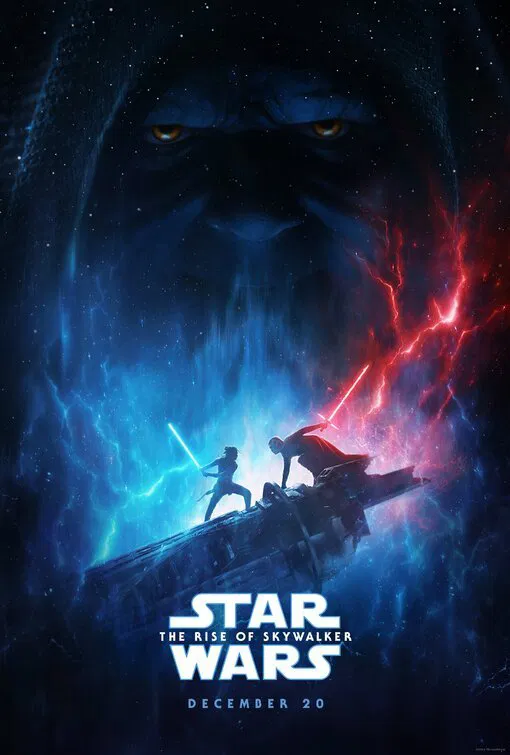“A Mixed Bag of Spectacular Fairytale Space Opera”
What You Need To Know:
STAR WARS: THE RISE OF SKYWALKER is the concluding chapter in the STAR WARS trilogy by George Lucas. The rebellion against the First Order’s tyrannical control of the galaxy discovers that Emperor Palpatine actually survived his fall at the end of RETURN OF THE JEDI. In the following, Palpatine has been building a fleet of Star Destroyers with planet-killing technology on the secret base of the evil Sith Lords. Princess Leia sends her Jedi apprentice Rey and her friends to locate the base so that the rebellion can go and destroy the Emperor once and for all.
THE RISE OF SKYWALKER rises above some paint-by-numbers plot mechanics and some serviceable acting to forge an emotional, exciting ending filled with acts of mercy, sacrifice, reconciliation, and hope. The character development in the third act is powerful. However, this positive content is marred by a false New Age, pagan worldview. The movie also has some foul language and a gratuitous perverse kiss in one brief scene inserted for purely political reasons. MOVIEGUIDE® advises extreme caution for STAR WARS: THE RISE OF SKYWALKER.
Content:
Strong, somewhat eclectic or mixed, New Age, dualistic pagan viewing supernatural power as residing in a living, impersonal energy “Force” (instead of a Personal God) that, if you get trained in using this “Force,” you can have more and more supernatural power to do good or do evil, and to even heal other people and animals who are wounded, with some Eastern mysticism where the bodies of Jedi Knights using the Light Side of the Force simply vanish when they die, slightly mitigated by strong redemptive, morally uplifting values and content that include sacrifice, mercy solves a major plot problem at one point, son reconciles with his father, resurrection and repentance occur, hope is a major theme in the movie, and people and aliens rise up against an evil selfish wannabe dictator who pursues absolute power over the lives of others, to the point of killing even those closest to him, plus a politically correct lesbian kiss between two women is inserted into a victory celebration to appease hedonists
Eight obscenities (“h” and “d” words with one “a**” word) and no profanities
Lots of strong and light action violence includes explosions, people battle with science fiction blaster guns and “rifles,” people fight with lightsabers or laser swords, character looks mortally wounded from a lightsaber wound, people use the Force while fighting, characters using the Force make gigantic leaps and jumps while fighting, space ships explode in whole or in part when hit by laser weapons, a planet is destroyed by a super-powerful version of such a weapon by a large spaceship, character is pushed into a chasm by a villain, villain uses Force to attack spaceships and people with electrical, lightning power
No sex scenes but there’s an image of two women kissing during a victory celebration
No nudity
Alcohol use in the background in one scene perhaps as heroes walk through an alien bar of some sort
No smoking or drugs; and,
Nothing else objectionable.
More Detail:
In the first act, the rebellion against the First Order discovers that Emperor Palpatine actually survived his fall at the end of RETURN OF THE JEDI. In the years after that, Palpatine has been building a fleet of Star Destroyers with planet-killing technology on the secret planetary headquarters of the Sith Lords, the evil order of Jedi Knights. Princess Leia sends her Jedi apprentice Rey and her friends to locate the secret Sith base. When they do, the rebellion can rally all freedom fighters to go there and destroy the Emperor once and for all.
However, Han Solo and Leia’s wayward son Ben, now calling himself Kylo Ren, has made contact with Palpatine. Palpatine wants Kylo to track Rey down and kill her, but Kylo has other plans. He follows Rey and her friends as they hunt for a Sith device that will reveal the secret Sith base. He wants Rey to join the Dark Side of the Force, kill Palpatne and rule the galaxy from the Sith throne.
Can Rey overcome Kylo Ren’s attempt to seduce her to the Dark Side? Will the rebels be able to rally the people against Emperor Palpatine and his forces?
THE RISE OF SKYWALKER rises above some paint-by-numbers plot mechanics and some serviceable acting to forge an emotional, exciting ending filled with acts of mercy, sacrifice, reconciliation, and hope. There was something special in the original STAR WARS trilogy in the relationship between Mark Hamill, Carrie Fisher and Harrison Ford. The new dynamic with Rey, Finn and Poe can’t quite duplicate that, though it’s not the sole fault of the three actors, who do a good job. The movie also has one or two dropped storylines. However, as the showdown between Rey, Han Solo’s son Kylo Ren and Emperor Palpatine approaches and arrives, Director J.J. Abrams and his actors (Daisy Ridley, Adam Driver and Ian McDiarmid) up the stakes and the story’s emotional ante. At the same time, the movie adds some gravitas to the battle between Rey and Kylo Ren, with a great assist from Mark Hamill as the spirit of Luke Skywalker and from cleverly edited scenes from the late Carrie Fisher, who died suddenly after the completion of the previous movie. The character development in the movie’s third act is some of the better writing in the whole STAR WARS saga.
THE RISE OF SKYWALKER also inserts some potent redemptive, uplifting content as the story comes to an end. At one major point in the climactic third act, for example, mercy helps solve a major plot problem. It’s a touching, really positive moment in the movie. The ending also promotes sacrifice, reconciliation and hope. In a recent press conference, Director J.J. Abrams said the movie’s major theme is hope, and the movie does indeed stress that at other points in the story, not just the third act.
This positive content in THE RISE OF SKYWALKER is marred by a false New Age, pagan worldview. As with all the other STAR WARS movies in the Skywalker saga, the supernatural power used by the heroes and villains, especially the main ones, resides not in a Personal God but in a living, impersonal energy “Force,” which can be used for good or evil. Thus, if people get trained in using this “Force” and even have a special ability for using it, they can have more and more supernatural power to do good or do evil, and to even heal other people and animals. For centuries, an elite force of Jedi Knights has been trained to keep peace and order throughout the galaxy, often to combat an evil cult of Jedi Knights calling themselves the Sith, who are masters at using the “Dark Side of the Force.” As in the other movies, when a Jedi Knight dies, his or her body vanishes. George Lucas borrowed this New Age vision from the work of notorious Anti-Semitic, Anti-Christian scholar Joseph Campbell, who was enamored with pagan religions, including Hinduism and especially Buddhism (Campbell became disenchanted with Hinduism after he visited India, but retained some of its pantheistic beliefs). Lucas also borrowed his creation of the Jedi Knights from Japanese samurai movies and Chinese folktales about swordsmen and women able to use the life energy or chi that’s present in all living things.
In addition to their origins in Eastern folklore, the STAR WARS movies are also like a fairy tale. After all, instead of “Once upon a time,” each movie opens with the phrase, “A long time ago in a galaxy, far, far away. . .” As such, they detail feats of derring do and adventure, in a science fiction setting. The movies are also a “space opera,” a subgenre of science fiction that stresses space warfare, melodramatic adventure, interplanetary battles, romance, quests, and acts of heroism.
THE RISE OF SKYWALKER continues that tradition. It also borrows the twin motif that runs throughout the trilogies. For example, Luke and Leia are twins. Also, there are two Death Stars in the first trilogy. Thus, at the end of THE RISE OF SKYWALKER, there are comments about the two becoming one. Also, at one crucial point in the story, Rey uses two lightsabers to fight.
THE RISE OF SKWALKER has lots of action violence that includes laser battles, lightsaber swordfights and explosions. There are also some brief, but mostly light obscenities. Finally, the movie has an image of two women kissing during one victory celebration. This homosexual kiss is a silly, gratuitous politically correct attempt to appease leftist radical activists.
All in all, because of its Eastern mysticism and New Age paganism, STAR WARS: THE RISE OF SKYWALKER warrants extreme caution. The writing, acting and directing in THE RISE OF SKYWALKER is satisfying and engaging, with some spectacular visual storytelling, though it may not rise to the level of the writing, acting and directing in THE EMPIRE STRIKES BACK, which is widely considered the best STAR WARS movie so far.


 - Content:
- Content: 





